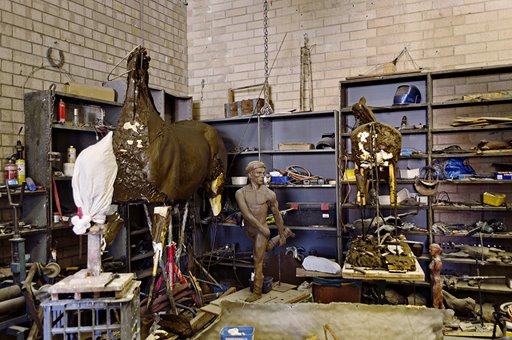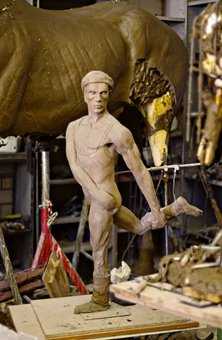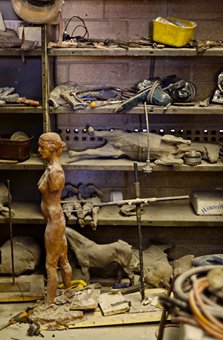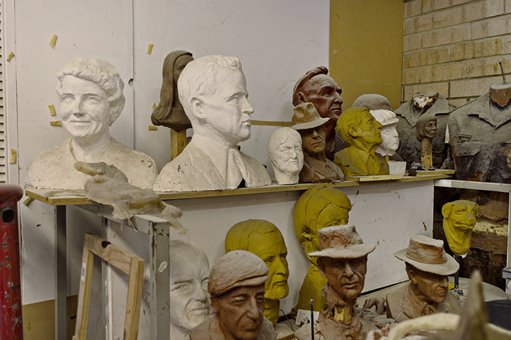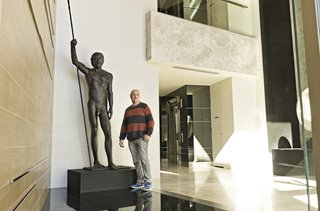 Communicating across generations
Communicating across generations
Words by Laetitia Wilson
The Indigenous Warrior stands proud, larger than life-size at 2.2 meters high, his body strong, his gaze determined. It is a bronze sculpture located in East Perth, by local artist Robert Hitchcock, who works tucked away in a warehouse studio in a semi-industrial area in Morley. Now in his seventies he has tirelessly worked away for weeks, years and decades on the labour-intensive process of bronze sculpting. His studio is bursting in works-in-progress, casts, tools, finished works and a wall of books, mostly on sculpture. While this is only one of his studios, it shows surely more than a lifetime’s worth of work.
He is still going strong and still treats his art practice very much like any other nine-to-five occupation. He is not overly fussed by the trends of the art world, which gives his art an enduring quality. Neither is he interested in socialising within the art scene, preferring to remain as somewhat of an outsider.
Of both Indigenous and Irish heritage, Hitchcock grew up at a time when there was little encouragement to identify with his Indigenous identity; this was something he would discover later in life. When he went to art school in the 1960s he started out in painting but due to trouble with his eyes and because he was a carpenter by trade, he found that sculpture was more his natural element. He was initially drawn towards realism and figurative techniques and although he could skilfully manage any style, he has continued carrying this tradition forward throughout his career, with the occasional more Modernist abstract sculpture. His practice was influenced initially by his art teachers at Perth Technical College and the likes of Auguste Rodin, Marino Marini, Alberto Giacometti and Frederick Remington. His sculptures can be seen dotted around the Perth metropolitan area and around Western Australia, such as the iconic sculpture near the Fremantle markets that shows Gerovich’s famous mark over Ray French at the 1956 preliminary WAFL final.
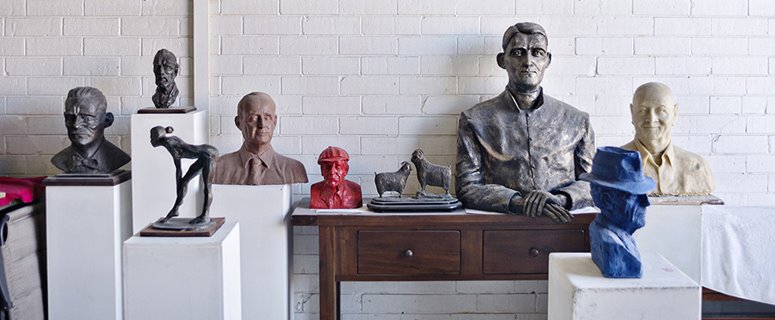 Certain themes define Hitchcock’s subject matter, with many busts, horses, dogs, ballet dancers and other figures as a result of commissions or driven by his own interests. The portraiture busts are clustered along one wall of the studio and dozens of eyes stare out. They bear a striking resemblance to the people they represent, be that Leonard Cohen, Van Gogh, Mary Raine or Banjo Paterson. Hitchcock is able to work from limited information, using just a photograph, or even a sketch to create a three dimensional likeness. A verisimilitude also carries through to the animals that he sculpts. As you enter the studio there is an especially striking eagle bearing down as though diving for prey. The detail in the feathers and commanding posture of the bird are striking.
Certain themes define Hitchcock’s subject matter, with many busts, horses, dogs, ballet dancers and other figures as a result of commissions or driven by his own interests. The portraiture busts are clustered along one wall of the studio and dozens of eyes stare out. They bear a striking resemblance to the people they represent, be that Leonard Cohen, Van Gogh, Mary Raine or Banjo Paterson. Hitchcock is able to work from limited information, using just a photograph, or even a sketch to create a three dimensional likeness. A verisimilitude also carries through to the animals that he sculpts. As you enter the studio there is an especially striking eagle bearing down as though diving for prey. The detail in the feathers and commanding posture of the bird are striking.
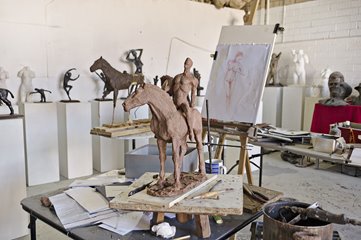
In all of his works there is close attention to the line of the bodies, giving them a sense of movement and tension. There is an internal dynamism, like a vital energy issuing forth from the otherwise static matter, making them both lithe and realistic.
This tempering of accuracy with energy can be seen in his public works around town. When celebrating NAIDOC week, most would be aware of the life-size sculpture of Yagan on Heirisson Island, the area known to Wadjuk Noongar people as Matagarup. Unveiled on 11 September 1984, this is one of the city’s most important memorials to Indigenous inhabitants.
Yagan stands as a warrior figure, representing resistance to occupation. He stands proudly on the island, naked with a spear placed across his shoulders. Famously and in a disturbing mimicry of past colonial acts, this sculpture was grossly beheaded twice around the time of the return of Yagan’s actual head from the United Kingdom in 1997. Hitchcock fastidiously attended to its repair.
While Yagan holds a special place for Hitchcock, he created the work so long ago that it has become a historical part of his life. Although connections to Hitchcock’s Aboriginality were discouraged growing up, as he was brought up Catholic, throughout his adult life he has come to understand his Aboriginality as an indelible part of his being. Wrestling with his Irish heritage he feels as though within him there is both identification with, and a distancing from, his Indigenous roots.
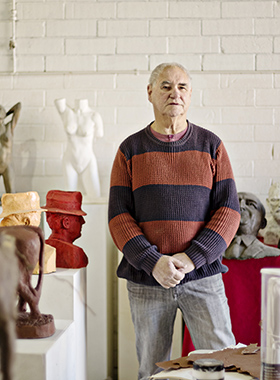
Identification has come about through strong spiritual and inexplicably surreal experiences with country. He also had a defining experience of connection in 1964, when he started chatting with some local Aboriginal people at Whim Creek and felt they were somehow on the same plane. In terms of his art, then, Hitchcock speaks about both feeling like a fraud amongst Aboriginal artists, because of the European nature of his art, but also feeling a deep sense of connection when not talking about art, because of a shared heritage and undeniable connection to country.
Hitchcock has proposed a sculpture of Wadjuk Noongar Fanny Balbuk Yooreel as a significant person to honour in bronze. So far there has not been any interest. Such a sculpture is overdue; Fanny was one of the key figures who carried the Noongar traditions forward and documentation of her knowledge contributed considerably to the Native Title Claim of 2006. She defiantly walked the path her family had for generations, well into the development of what is now the Perth CBD, famously knocking down fences and walking through houses built without consultation.
As the NAIDOC theme celebrates languages this year, it is good to be reminded of not only the preservation of Indigenous languages but also of the vitality of communicating across generations the importance of events of the past and such significant figures as Yagan and Yooreel. Hitchcock is aware of this and is well placed to make memorials that will stand the test of time. Whether it honours the living or memorialises the dead, a work in bronze is an unexpected and enduring blessing, when so many aspects of traditional cultures are under threat.
Laetitia Wilson is a local freelance writer, lecturer and curator with an interest in Contemporary Art and a PhD in Media Arts.
Images (top to bottom):
-
Robert Hitchcock with The Indigenous Warrior, 2017. Photographer: Sue-Lyn Moyle
-
Robert Hitchcock, works in studio, 2017. Photographer: Sue-Lyn Moyle
-
Robert Hitchcock, work in progress, 2017. Photographer: Sue-Lyn Moyle
-
Robert Hitchcock in studio, 2017. Photographer: Sue-Lyn Moyle
-
(below) Robert Hitchcock, horse and Rudolph Nurayev works in studio, 2017. Photographer: Sue-Lyn Moyle
